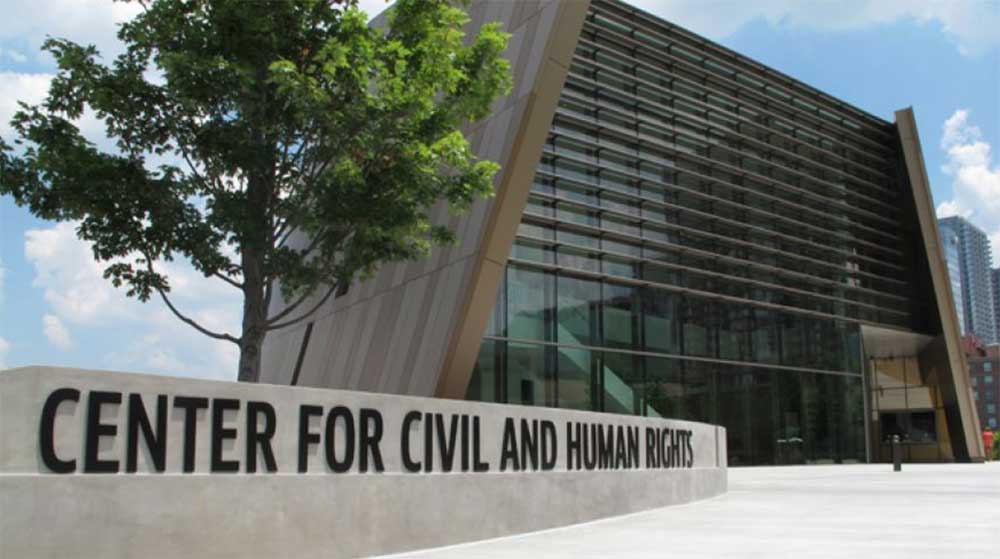
IHRC student Christina Santora
As a student in the International Human Rights Clinic, I recently attended the 10th Annual Business and Human Rights Conference at the Coca-Cola Company’s World Headquarters in Atlanta Georgia as part of my research for a clinic project. The conference featured panelists and speakers from several different businesses and organizations, including The Coca-Cola Company, Walmart, Heineken, HP, IBM, Anthem, the International Labor Organization, the International Organization of Employers, United States Council for International Business, and the Tent Partnership for Refugees. These panels discussed such topics as: the UN Human Rights Council’s “Protect, Respect, and Remedy” framework, “Human Rights Defenders: What Businesses Can And Should Do,” and “Key Initiatives on Business and Human Rights at a National and International Level”.

Panel at the 10th Annual Business and Human Rights Conference at the Coca-Cola Company’s World Headquarters in Atlanta Georgia
The conference began by reflecting on the implementation of the business and human rights “Protect, Respect, and Remedy” framework over the last 10 years. This framework was first approved by the United Nations in 2008 and Guiding Principles were issued in 2011. Although there have been significant improvements in the realm of business and human rights, this is still a challenging issue and is exacerbated, for example, by the fact that more than a hundred countries currently have laws limiting peoples’ rights to expression, association, and assembly.
Abby Maxman, President of Oxfam America, discussed the impact of the “Protect, Respect, and Remedy” framework, and suggested ways in which stronger collaborations between governments and businesses are necessary in the area of human rights. For example, governments could offer incentives and rewards for the businesses that improve their practices, rather than simply criticize businesses for not doing enough. Mthunzi Mdwaba, Chair of the International Organization of Employers Policy Working Group on Human Rights and Responsible Business Conduct, also emphasized the importance of such initiatives between governments and businesses to protect human rights. He stressed that businesses must be more open to government regulations, particularly where the goal is to protect human rights.
Later in the day, a panel addressed the challenges facing human rights defenders and the role that businesses could play in alleviating those struggles. Human rights and environmental defenders are being criminalized and/or killed in several countries, including Honduras, India, Nigeria, and Thailand. The panel addressed various measures that business can take to address this problem, including engaging with human rights defenders at a local level, giving defenders access to resources, and practicing due diligence.
Attending this conference was a wonderful learning experience. I gained so many takeaways about the broad topic of “business and human rights”, and how initiatives taken by businesses to protect human rights play out in the world. Additionally, I was able to meet other people who are passionate about human rights and work to make meaningful change. I hope to attend the 11th annual conference next year!

The Center for Civil and Human Rights
Bonus: The Center for Civil and Human Rights
While I was in Atlanta, I had the opportunity to visit the Center for Civil and Human Rights, a three-floor museum with exhibits dedicated to Martin Luther King, Jr., what it was like living in the Civil Rights Era, being a part of the movement, and human rights in the past, present, and future. The Martin Luther King, Jr. exhibit gave me an insight into MLK as a person, a scholar, a leader, and a champion for human rights. It featured several of his letters and handwritten speeches, all corresponding to different articles of the Universal Declaration of Human Rights.
The American Civil Rights Exhibit provided an extraordinary look into the Civil Rights Movement. It begins with a segregated hallway with photos of “colored” people on one wall and “whites” on the opposite. There were rooms dedicated to the Freedom Riders, the March on Washington, and the violence inflicted on communities of color following the March. The most powerful part of this exhibit was a “lunch counter simulation” in which you participate in a sit-in protest. You sit at the counter, put on earphones, put your hands face-down on the counter, closer your eyes, and wait. The fear sets in within seconds when a voice begins snarling derogatory names and remarks into your ear. The terror from this experience is only a small fraction of what the actual Civil Rights protesters were subjected to, but it helps to put their heroism into perspective.
The final exhibit is dedicated to the Global Human Rights Movement. It begins by demonstrating the history of human rights law and features the Universal Declaration of Human Rights. There is a room dedicated to the people, places, and resources that are currently threatened and need to be protected. Another room has dichotomy much like the segregated hallway in the Civil Rights exhibit. On one wall some of the greatest defenders of human rights are featured, including Nelson Mandela, Gandhi, MLK, and Mother Teresa. On the opposing wall, the greatest violators of human rights are portrayed, including Hitler and Joseph Kony. This exhibit offers a fresh take and interesting perspective on human rights.
Overall, I am thankful for the opportunity to learn more about the emerging issues involving businesses and human rights, and for the eye-opening visit to the Center for Civil and Human Rights.